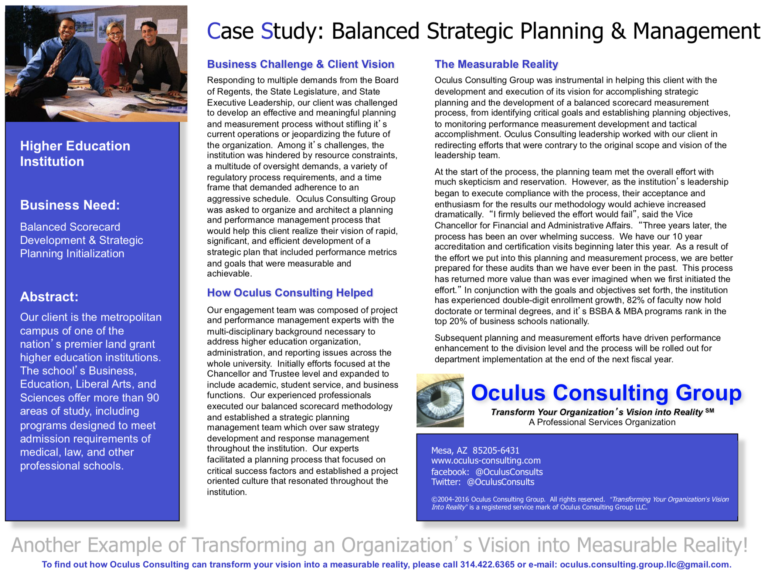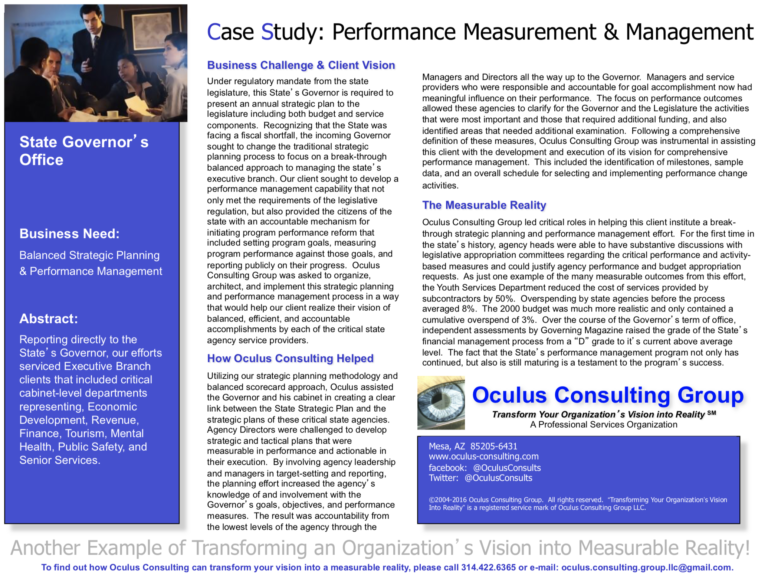Setting A Purposeful Direction For Performance Measurement Improvement Efforts
Performance targets at the organizational level should be descriptive without being overly prescriptive, should focus on the organization’s key results areas, be “high enough” in target level reflecting the quantification of the organization’s key initiatives, and be challenging while remaining realistically achievable.

By Oculus Consulting Group LLC
Everyone is measuring performance. And the appetite for more metrics is nearly insatiable. Private organizations maintain that performance measures are critical for their success. Public managers are measuring the performance of their organizations, their contractors, and the arenas in which they participate. Congress, state legislatures, and city councils are insisting that their executive-branch agencies periodically report on measures of performance. Stakeholder organizations want performance measures so they can hold their government accountable. Journalists like nothing better than a front-page bar chart that compares performance measures for various jurisdictions – whether they are average test scores for the city’s schools, trend lines for an organization’s sales or profits, or FBI uniform crime statistics for the state’s cities as a sample of the plethora of measures available. Moreover, public agencies are taking the initiative to publish compilations of their own performance measurements. If you introduce the topic of appropriate performance metrics in education into this conversation, the resulting discussion may never approach consensus. Match all of this with the speed and intensity of dispensing performance metrics to today’s highly mobile and social media-fed users, and the complexity surrounding appropriate organization-wide metrics can be highly contentious.
Why Measure Performance?
Have you stopped to ponder what is behind all of this measuring of performance? What do people expect to do with the measures – other than use the metrics to beat up on some underperforming team member, organization, agency, bureaucrat, or endeavor? Leaders of organizations are constantly asking themselves how are people using these performance measures? After all, neither the act of measuring performance nor the resulting data accomplish anything itself; it is only when someone uses these measures in some way does the information accomplish something.
“Your organization can achieve the symphony of “common good” by ensuring that your key result areas and key indicators are linked and aligned with your organization’s vision, mission, strategic plans, and performance targets.”
One of the greatest challenges facing leaders within today’s organizations is exactly how to coordinate and align organization-wide improvement priorities. Imagine for a moment, what an orchestra would sound like if all the musicians played their solos simultaneously? Without coordination and alignment of the individual parts, the result would be less than entertaining. It would not matter how many hours of practice and preparation had been expended by the soloists, nor that the musicians would be doing their absolute very best individually, the orchestra experience as a whole would probably be sub-optimizing to both the performers and the audience. Yet, this simple analogy still demonstrates one of the most current problems in today’s hyper-intensive, light speed reactive technology environment. Like the orchestra in our example, every organization must coordinate its processes and performance metrics in pursuing its goals toward achieving maximum performance. Your organization can achieve the symphony of “common good” by ensuring that your key result areas and key indicators are linked and aligned with your organization’s vision, mission, strategic plans, and performance targets.
But, the “common good” for the entire symphony orchestra will hardly answer this question: What will our managers do with all of this reliable and valid information? Producing reliable and valid reports of organizational performance is no end in itself. All of the reliable and valid data about performance is of little use to your organization’s managers if they lack a clear idea about how to use them or if the data are not appropriate for this particular use. So what, exactly, will performance measurement do, and what kinds of measures do your managers need to do this? Indeed, what is the logic behind all of this performance measurement – the causal link between the measures and your manager’s effort to achieve specific strategic purposes?





To Evaluate How Well Is Our Organization Performing?
Organizations need to know where they are going, and whether or not they’ve reached their destination. No wonder many managers within organizations are alarmed by the evaluative nature of performance measurement. If there existed a clear, universal understanding of their performance objectives, and if they could manage within a rational program structure, they might find performance measurement less scary. But without an agreement on these objectives, managers know that others can use performance data to criticize them (and their departments) for failing to achieve objectives that they were not pursuing. And if these same managers are given responsibility for achieving widely accepted performance objectives with a technologically infatuating structure (multiple constraints, inadequate resources, and unreasonable timetables), even the most talented managers may fall short of the agreed-upon performance targets.
Performance targets at the organizational level should be descriptive without being overly prescriptive, should focus on the organization’s key results areas, be “high enough” in target level reflecting the quantification of the organization’s key initiatives, and be challenging while remaining realistically achievable.
To Control How Can Managers Ensure Their Subordinates Are Doing the Right Thing?
In their original explanation of the balanced scorecard, Robert Kaplan and David Norton note that business has a control bias: “Probably because traditional measurement systems have sprung from the finance function, the systems have a control bias. That is, traditional performance measurement systems specify the particular actions they want employees to take and then measure to see whether the employees have taken those actions. In that way, the systems try to control behavior”. That same control behavior applies to your organization.
For example, the target of developing and securing a specific number of new patents or customers within a period of time may seem to fall within the domain of the R & D or Sales groups within your organization. But what about the roles of the other groups in the organization who support either of these two groups? How do you control the efforts of teams of resources in purchasing, marketing research, etc., that support these two groups? At Oculus Consulting Group LLC, our workshops and development initiatives can help you develop the appropriate control measures without stifling the creativity and energy of your organization.
To Motivate How Managers Motivate Line Staff, Middle Managers, Organizational Collaborators, Stakeholders, and Customers to Do the Things Necessary to Improve Performance?
Managers may use performance measures to learn how to perform better. Or, if they already understand what it takes to improve performance, they may use the measures to motivate such behavior. And for this motivational purpose, performance measures have proven to be very useful. The basic concept is that establishing performance goals – particularly stretch goals – grabs people’s attention. Then the measurement of progress toward the goals provides useful feedback, concentrating their efforts on reaching these targets.
To implement this motivational strategy, an organization’s leadership needs to give its people a significant goal to achieve and then use performance measures – including interim targets-to focus people’s thinking and work and to provide a periodic sense of accomplishment. Moreover, performance targets may also encourage creativity in evolving better ways to achieve the goal; thus, measures that motivate improved performance may also motivate learning.
To Celebrate Accomplishments That Are Worthy of the Important Organizational Ritual of Celebrating Success?
All organizations need to commemorate their accomplishments. Such rituals tie people together, give them a sense of their individual and collective relevance, and motivate future efforts. Moreover, by achieving specific goals, people gain a sense of personal accomplishment and self-worth. Such celebrations of performance accomplishment need not be limited to one big party to mark the end of the fiscal year or the completion of a significant project. Small milestones along the way – as well as unusual achievements and unanticipated victories – provide an opportunity for impromptu celebrations that call attention to these performance measurement accomplishments and to the people who made them happen. And such celebrations can help to focus attention on the next challenge.
The celebration also may be combined with learning. Rather than hold a party to acknowledge success and recognize its contributors, an informal seminar or formal presentation could realize the same purposes. Asking those who produced the unanticipated achievement or unusual victory to explain how they pulled it off celebrates their triumph, but it also provides others with an opportunity to learn how they might achieve similar success.
To Learn What Is Working or Not Working?
To learn from performance measures, however, managers need some mechanism to extract information from the data. We may all believe that the data will speak for itself. This, however, is only because we each have buried in our brain some unconscious mechanism that has already made an implicit conversion of the abstract data into meaningful information. Data speaks only through an interpreter that converts the collection of digits into analog lessons – someone that understands how to decode the otherwise inscrutable numbers and provides a persuasive explanation. And often, different people use different interpreters, which explains how they can draw very different lessons from the same data.
Furthermore, learning can help more directly with the process of improving. The performance measures can reveal not only whether an organization is performing well or poorly, but also why: What is contributing to the organization’s excellent, fair, or poor performance-and what might be done to improve the components that are performing fairly or poorly?
To Improve What Exactly Should Be Done Differently to Improve Performance?
Performance “‘measurement’ is not an end in itself but must be used by managers to make “improvements”. For example, if the measurement produces some learning, someone then must convert that learning into an improvement. Someone has to intervene consciously and actively. Learning from performance measures, however, is tricky. It isn’t obvious what lessons managers should draw about which factors are contributing to good or poor performance, let alone how they might modify such factors to foster improvements. Improvement requires attention to the feedback – the ability to check whether the lessons postulated from the learning have been implemented in a way that actually changes organizational behavior so that it results in the better outputs and outcomes that the learning promised. Improvement is active, operational learning. The challenge of learning from performance measures is both intellectual and operational. To measure an organization’s performance in a way that can help improve its performance, the organization’s leadership needs to think seriously not only about what it should measure, but also about how it might deploy any such measurements. Indeed, without at least some tentative theory about how the measurements can be employed to foster improvements, it is difficult to think about what should be measured.
Concluding Thoughts
Performance measurement is not an end in itself. So why should managers measure performance? Because they may find such measures helpful in achieving the specific managerial purposes we’ve identified above. As part of their overall management strategy, organizations can use performance measures to evaluate, control, budget, motivate, promote, celebrate, learn, and improve. Unfortunately, no single performance measure is appropriate for all of these purposes. Consequently, managers should not seek one magic performance measure. Instead, they need to think seriously about the managerial purposes to which performance measurement might contribute and how they might deploy these measures. Only then can they select measures with the characteristics necessary to help achieve each purpose.
At Oculus Consulting Group LLC, we understand how the proper definition of adequate performance measures can mean the difference between successful responses to innovative technologies, dynamic technology application changes, responding to disruptive innovation, and the need for substantial organization transformation. Our demonstrated achievements in assisting our clients to transform their vision for positive performance measurement and management effectiveness into a measurable reality of enhanced organization performance can assist your organization as you proceed with similar efforts.
To learn how you can secure our services and assistance, please contact us.
© 2018-2021 Oculus Consulting Group LLC
Oculus Consulting Group LLC and “Transform Your Organization’s Vision into a Measurable Reality are registered service marks of Oculus Consulting Group LLC.

This Post Has One Comment
I am a long-time devotee, certified, and a facilitator of the 4 Disciplines of Execution. The measurements of performance are necessary along with accountability, consistency of reporting and regular communication, celebration of small wins, and much more. Thanks for publishing this very purposeful and detailed paper.